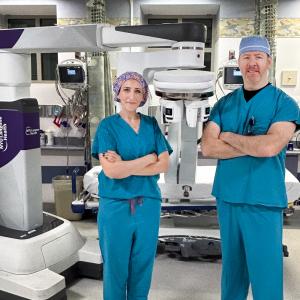NYU Winthrop is one of the first hospitals in Long Island to offer the world’s smallest, leadless pacemaker to help treat patients with bradycardia, a slow heart rhythm. The Micra™ Transcatheter Pacing System (TPS), is a new device that provides patients with the most advanced pacing technology at one-tenth the size of a traditional pacemaker with no leads.
Nearly 1 million people worldwide are implanted with pacemakers each year. The leads in a traditional single chamber pacemaker run from the device, implanted under the skin near the collarbone, through a vein directly into the heart’s right ventricle. These leads deliver electric pulses from the generator to the right ventricle and help coordinate timing of the heart chamber’s contractions. Among its advantages, the Micra™ TPS eliminates these leads which can sometimes malfunction or cause problems when infections develop in the surrounding tissue, requiring a surgical procedure to replace the device. While the Micra™ TPS system works like other pacemakers to regulate heart rate, this self-contained, inch-long device is implanted directly in the right ventricle which pumps blood out of the heart.
People who have bradycardia usually experience an irregular heart rhythm of fewer than 60 beats per minute. At this rate, the heart is unable to pump enough oxygen-rich blood to the body during normal activity or exercise, causing dizziness, fatigue, shortness of breath, or fainting spells. Pacemakers are the most common way to treat bradycardia to help restore the heart’s normal rhythm and relieve symptoms by sending electrical impulses to the heart to increase its rhythm.
Approved by the U.S. Food and Drug Administration in April 2016, the Micra™ TPS has been granted Medicare coverage, allowing broad patient access to the novel pacing technology.
Electrophysiologist Manish Undavia, MD, performed the first leadless pacemaker procedure at NYU Winthrop, which is available to select patients who qualify.
“Not everyone is a candidate, including patients who have implanted devices that would interfere with the pacemaker, those who are severely obese, and those who have intolerance to materials in the device or to the blood thinner, heparin,” says Dr. Undavia. “We do however, have great hope for the technology helping scores of patients at NYU Winthrop.”

